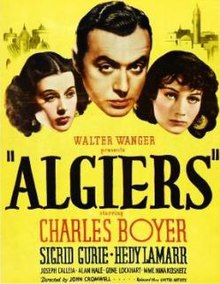 |
American director Nicholas Ray would, at first glance, seem to be a rather curious choice to helm a World War II action film. Better known for such classics as THEY LIVE BY NIGHT (1949), IN A LONELY PLACE (1950), ON DANGEROUS GROUND (1952), MACAO (1952), REBEL WITHOUT A CAUSE (1955) and BIGGER THAN LIFE (1956), Ray did have one war movie, FLYING LEATHERNECKS (1951) under his belt. And a Nicholas Ray directed war movie is bound to be something different from the usual run of the mill fare.
BITTER VICTORY (1957) is the story of two men, Major David Brand (Curt Jurgens) and Captain Jim Leith (Richard Burton) who clash in North Africa during WWII. As it turns out, Leith, a combat veteran, had a brief but torrid affair with Jane (Ruth Roman), before she married Brand. Leith still carries a torch for Jane and she is still romantically attracted to the dashing young soldier.
The British high command orders a commando raid on Benghazi to capture Nazi documents stored there. It's a dangerous mission but Brand, with no field experience, is given command of the operation due to his seniority and rank. Leith is assigned his second in command. The rest of the squad is composed of veteran British actors including Nigel Green and Christopher Lee.
Ray wastes no time in getting the men to their objective where Brand freezes under stress, unable to kill a German sentry. It's up to Leith to do the dirty work and the operation continues. The men get the documents as ordered and put their escape plan into action. But the camels that were supposed to carry the men back to the rendezvous point don't show up, forcing the men to set off across the North African desert on foot.
They're ambushed by a Nazi patrol and a vicious gun battle leaves most of the Germans dead except for Colonel Lutze (Fred Matter), whom the commandos take prisoner. Brand is clearly in over his head and he depends upon Leith to make the hard decisions. But when Brand sees a scorpion about to attack Leith, he does nothing to interfere, letting the man be stung, becoming unable to continue the journey. When a fierce sand storm erupts, it's Leith that saves Brand from certain death, dying in the process. The rest of his men believe Brand killed Leith and view him with suspicion for the rest of the trek.
The men finally meet up with British forces but while celebrating, they ignore Colonel Lutze who puts the bags containing the documents to the torch. Only one bag is able to be salvaged but it's enough for Brand to be recognized as a hero by the British top brass and awarded a medal for heroism under fire, a medal he most certainly doesn't deserve.
BITTER VICTORY is an interesting, offbeat and first rate little war movie that is unflinching it depicting some rather atrocious war crimes (on both sides). Burton and Jurgens seem to genuinely hate each other while Roman harbors deep feelings for both men. Cynical and uncompromising, BITTER VICTORY is well worth seeing for fans of Nicholas Ray and World War II films.
Recommended.
|
Friday, July 26, 2019
BITTER VICTORY
Wednesday, July 24, 2019
GRACE
 |
Somewhere between Roman Polanski's masterpiece of urban horror, ROSEMARY'S BABY (1968) and the over-the-top insanity of Larry Cohen's monster baby epic IT'S ALIVE (1974) lies GRACE (2009). This low budget, independent Canadian horror film borrows a great deal from the body horror oeuvre of fellow Canadian David Cronenberg in it's depiction of motherhood gone horribly wrong.
Madeline (Jordan Ladd), is a pregnant young woman whose husband, Michael (Stephen Park), dies in a car accident before the baby is born. The accident also leave the baby dead but Madeline decides to let the corpse go full term and be delivered anyway, telling everyone that the infant died at birth. But somehow, the baby girl named Grace, comes alive after delivery. Is it a miracle? Or something far more sinister.
It's the sinister option, of course, with young Grace refusing to accept breast milk in lieu of something else: blood. And not just any blood as Madeline finds out when she tries to feed Grace blood drained from fresh cuts of meat. No, little Grace demands human blood and she ravenously takes it from her anemic mother. Madeline is soon forced to find a supply of human blood that doesn't involve the ravaging her nipples and breasts. She finds that source in the form of a meddling Dr. Sohn (Malcolm Stewart) and Vivian (Gabrielle Rose), her grief stricken mother-in-law. But by then it's too late as Madeline herself has succumbed to the curse of needing human blood herself. And things ratchet up another notch in the last scene of the film when young Grace starts teething, implying a need for both blood and flesh.
GRACE is a very well made little shocker which touches on some extremely disturbing themes and many "really-wish-I-hadn't-seen-that" scenes of shockingly intimate blood and gore. Not for the faint of heart, GRACE is a slowly building exercise in maternal terror and dread with no explanation given for why this living dead baby has come to be. She simply is and Madeline will do anything to protect and provide for her.
This film is certainly not every one's cup of tea but for fans of modern, independent horror films, GRACE is definitely worth seeing.
|
Tuesday, July 23, 2019
WHITE ZOMBIE
Monday, July 15, 2019
ANOTHER SON OF SAM
Saturday, July 13, 2019
ALGIERS
Thursday, July 4, 2019
THE CAT BURGLAR
Subscribe to:
Posts (Atom)



